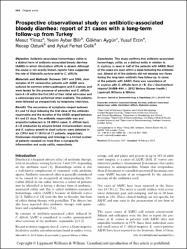| dc.contributor.author | Yılmaz, Mesut | |
| dc.contributor.author | Bilir, Yeşim Aybar | |
| dc.contributor.author | Aygün, Gökhan | |
| dc.contributor.author | Erzin, Yusuf Ziya | |
| dc.contributor.author | Öztürk, Recep | |
| dc.contributor.author | Çelik, Aykut Ferhat | |
| dc.date.accessioned | 10.07.201910:49:13 | |
| dc.date.accessioned | 2019-07-10T19:52:29Z | |
| dc.date.available | 10.07.201910:49:13 | |
| dc.date.available | 2019-07-10T19:52:29Z | |
| dc.date.issued | 2012 | en_US |
| dc.identifier.citation | Yılmaz, M., Bilir, Y. A., Aygün, G., Erzin, Y. Z., Öztürk, R. ve Çelik, A. F. (2012). Prospective observational study on antibiotic-associated bloody diarrhea: report of 21 cases with a long-term follow-up from Turkey. European Journal of Gastroenterology & Hepatology, 24(6), 688-694. https://dx.doi.org/10.1097/MEG.0b013e328352721a | en_US |
| dc.identifier.issn | 0954-691X | |
| dc.identifier.uri | https://dx.doi.org/10.1097/MEG.0b013e328352721a | |
| dc.identifier.uri | https://hdl.handle.net/20.500.12511/2410 | |
| dc.description | WOS: 000303826200012 | en_US |
| dc.description | PubMed ID: 22433794 | en_US |
| dc.description.abstract | Objective Antibiotic-associated hemorrhagic colitis is a distinct form of antibiotic-associated bloody diarrhea (AABD) in which Clostridium difficile is absent. Although the cause is not exactly known, reports have suggested the role of Klebsiella oxytoca and/or C. difficile. Materials and Methods Between 2001 and 2006, stool samples of 21 consecutive patients with AABD were cultured for common enteric pathogens and K. oxytoca, and were tested for the presence of parasites and C. difficile toxin A + B within the first 24 h of their initial admission and a colonoscopy was performed when available. The patients were followed up prospectively by telephone interviews. Results The occurrence of symptoms ranged between 6 h and 14 days following the first dose of the antibiotic responsible and the duration of the AABD ranged between 6 h and 21 days. The antibiotic responsible was oral ampicillin/sulbactam in 18 (85%) cases. C. difficile toxin A + B production by enzyme-linked immunosorbent assay and K. oxytoca growth in stool cultures were detected in six (29%) and 11 (51%) of 21 patients, respectively. Endoscopic morphology and histology in a limited number of patients revealed no more than a nonspecific inflammation and acute colitis, respectively. Conclusion This study confirms that antibiotic-associated hemorrhagic colitis, as a distinct entity in relation to K. oxytoca, is seen in half of the patients with AABD. Most of the cases are seen within a week following the antibiotic use. Almost all of the patients did not develop any flares during the long-term antibiotic-free follow-up. In some of the patients with AABD, there was coexistence of K. oxytoca with C. difficile toxin A + B. Eur J Gastroenterol Hepatol 24: 688-694 | en_US |
| dc.language.iso | eng | en_US |
| dc.publisher | Lippincott Williams & Wilkins | en_US |
| dc.rights | info:eu-repo/semantics/openAccess | en_US |
| dc.subject | Antibiotic-Associated Bloody Diarrhea | en_US |
| dc.subject | Antibiotic-Associated Hemorrhagic Colitis | en_US |
| dc.subject | Clostridium Difficile | en_US |
| dc.subject | Klebsiella Oxytoca | en_US |
| dc.title | Prospective observational study on antibiotic-associated bloody diarrhea: report of 21 cases with a long-term follow-up from Turkey | en_US |
| dc.type | article | en_US |
| dc.relation.ispartof | European Journal of Gastroenterology & Hepatology | en_US |
| dc.department | İstanbul Medipol Üniversitesi, Tıp Fakültesi, Dahili Tıp Bilimleri Bölümü, Enfeksiyon Hastalıkları ve Klinik Mikrobiyoloji Ana Bilim Dalı | en_US |
| dc.authorid | 0000-0001-8022-7325 | en_US |
| dc.identifier.volume | 24 | en_US |
| dc.identifier.issue | 6 | en_US |
| dc.identifier.startpage | 688 | en_US |
| dc.identifier.endpage | 694 | en_US |
| dc.relation.publicationcategory | Makale - Uluslararası Hakemli Dergi - Kurum Öğretim Elemanı | en_US |
| dc.identifier.doi | 10.1097/MEG.0b013e328352721a | en_US |
| dc.identifier.wosquality | Q4 | en_US |
| dc.identifier.scopusquality | Q2 | en_US |


















